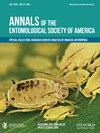蚂蚁的耐热性:变异的方法、假设和来源综述
IF 1.8
3区 农林科学
Q1 ENTOMOLOGY
引用次数: 33
摘要
摘要蚂蚁(膜翅目:蚁科)是一类明显的外热生物,其行为、分布、生理和适应性受温度的调节。因此,在过去几十年里,人们对蚂蚁在多变气候中生存和茁壮成长的耐热性等特性的兴趣呈指数级增长。在这里,我们综合了已发表的关于蚂蚁耐热性的文献。我们从讨论常见指标开始审查:临界热极限、致命热极限、耐撞击性、冷昏迷恢复和过冷。特别是,我们强调了每个热量指标的量化方式,并提供了一套方法上的注意事项供考虑。接下来,我们将描述蚂蚁沿着空间和时间温度梯度的耐热性模式和假设。在空间上,我们关注与纬度、海拔、城市化和小气候的关系。在时间上,我们关注季节可塑性、日常变化、优势热耐受性权衡和适应。我们进一步讨论了变异的其他来源,包括进化史、体型、年龄、种姓和营养。最后,我们强调了蚂蚁热生物学家感兴趣的几个主题,从方法开发到气候变化的影响。本文章由计算机程序翻译,如有差异,请以英文原文为准。
Ant Thermal Tolerance: A Review of Methods, Hypotheses, and Sources of Variation
Abstract Ants (Hymenoptera: Formicidae) are a conspicuous group of ectotherms whose behavior, distribution, physiology, and fitness are regulated by temperature. Consequently, interest in traits like thermal tolerance that enable ants to survive and thrive in variable climates has increased exponentially over the past few decades. Here, we synthesize the published literature on the thermal tolerance of ants. We begin our review with discussion of common metrics: critical thermal limits, lethal thermal limits, knock-down resistance, chill-coma recovery, and supercooling. In particular, we highlight the ways each thermal metric is quantified and offer a set of methodological caveats for consideration. We next describe patterns and hypotheses for ant thermal tolerance along spatial and temporal temperature gradients. Spatially, we focus on relationships with latitude, elevation, urbanization, and microclimate. Temporally, we focus on seasonal plasticity, daily variation, dominance-thermal tolerance tradeoffs, and acclimation. We further discuss other sources of variation including evolutionary history, body size, age, castes, and nutrition. Finally, we highlight several topics of interest to ant thermal biologists, ranging in scope from methods development to the impacts of climate change.
求助全文
通过发布文献求助,成功后即可免费获取论文全文。
去求助
来源期刊
CiteScore
4.90
自引率
0.00%
发文量
25
审稿时长
6-12 weeks
期刊介绍:
The Annals of the Entomological Society of America exists to stimulate interdisciplinary dialogue across the entomological disciplines and to advance cooperative interaction among diverse groups of entomologists. It seeks to attract and publish cutting-edge research, reviews, collections of articles on a common topic of broad interest, and discussion of topics with national or international importance. We especially welcome articles covering developing areas of research, controversial issues or debate, and topics of importance to society. Manuscripts that are primarily reports of new species, methodology, pest management, or the biology of single species generally will be referred to other journals of the ESA. The most important criteria for acceptance are quality of work and breadth of interest to the readership.

 求助内容:
求助内容: 应助结果提醒方式:
应助结果提醒方式:


